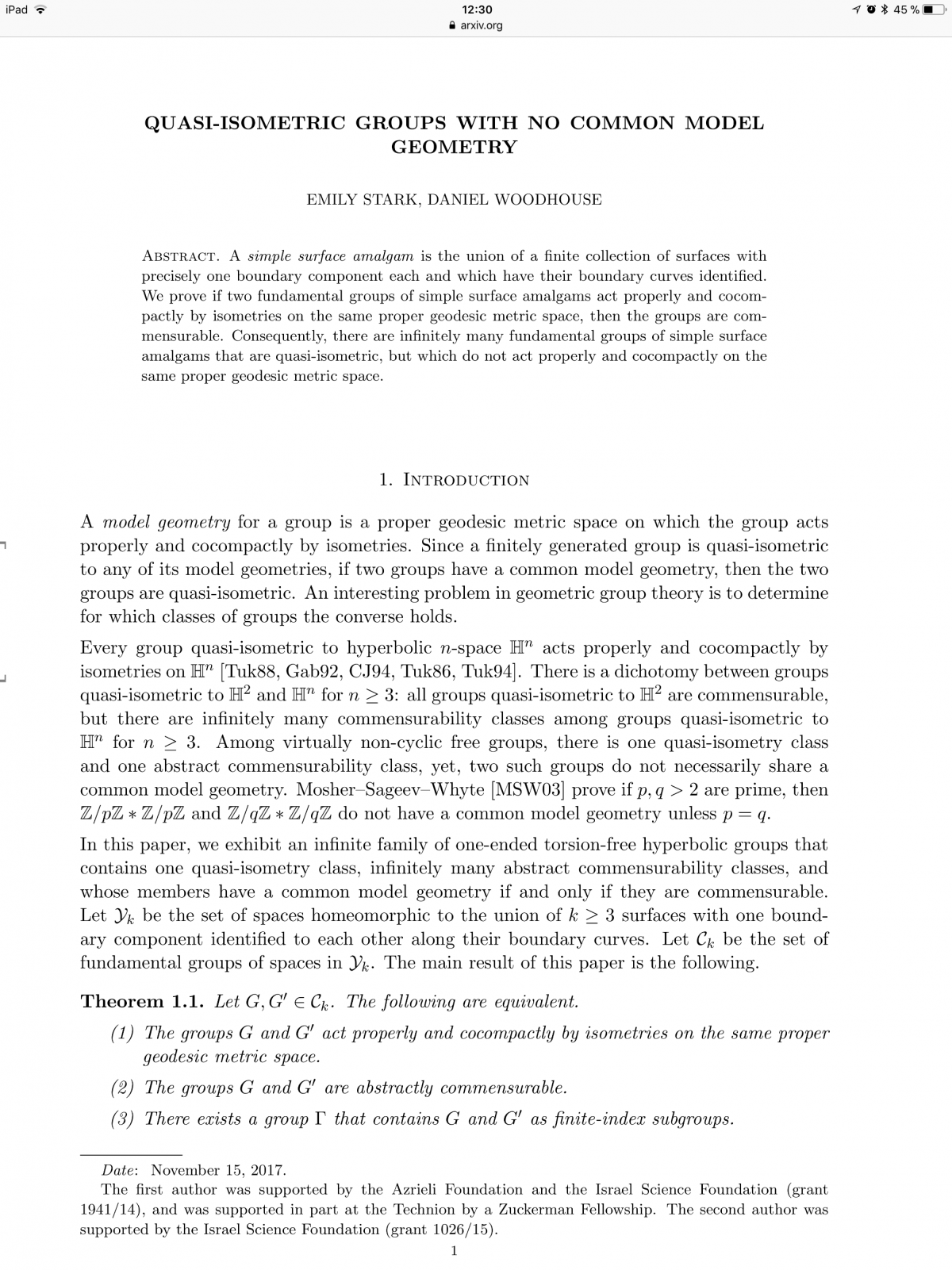Do quasi-isometries between groups always arise from actions on a common model space? Previous counterexamples invoked central extensions of lattices, e.g., of surface groups. A new construction of infinitely many classes is now using amalgams of surface groups.
Stark, Woodhouse: Quasi-isometric groups with no common model geometry,
https://arxiv.org/pdf/1711.05026.pdf
If a group \(\Gamma\) acts geometrically (i.e., properly and cocompactly) on a space $X$, then it is quasi-isometric to $X$ by the Milnor-Svarc theorem. Thus, a standard way of proving two groups to be quasi-isometric is to let them act geometrically on the same space. For example, hyperbolic space in dimensions \(\ge 3\) admits many geometric actions by non-commensurable groups which are thus quasi-isometric.
One may ask for the converse: do quasi-isometries between groups always arise from geometric action on a common model space. (Note that groups always act geometrically on some space, namely their Cayley graph. However, the quasi-isometry between the Cayley graphs of two quasi-isometric groups only serves to promote an action on one Cayley graph to a quasi-action on the other and it is not always the case that a quasi-action can be promoted to an actual action.)
Known examples of quasi-isometric groups not having a common model geometry arise as groups of the form
\(\Gamma\times{\mathbb Z}\mbox{ and }\overline{\Gamma},\)
where \(\Gamma\subset G\) is a uniform lattice in a simple Lie group \(G\) with \(\pi_1G={\mathbb Z}\).
If $G$ has property $T$, then \(\overline{\Gamma}\) also does, while
\(\Gamma\times{\mathbb Z}\) does not, thus the two groups can not be quasi-isometric.
This argument does not apply to \(G=SL(2,{\mathbb R})\), i.e., for surface groups \(\Gamma\), but in this case another argument applies. Two groups \(\Gamma, \Lambda\) are called measure equivalent if they have a (not necessarily cocompact) proper action with finite-volume fundamental domains \(X_\Gamma,X_\Lambda\) on some measure space. Such a measure equivalence defines a coccycle \(\alpha\colon\Gamma\times X_\Lambda\to\Lambda \) by figuring out in which copy of the fundamental domain \(X_\Lambda\) an element \(\gamma x\) with \(\gamma\in\Gamma, x\in X_\Lambda\) lies. In the case of \(\Gamma\times{\mathbb Z}\mbox{ and }\overline{\Gamma}\) with \($\Gamma\subset SL(2,{\mathbb R})\) it turns out that the groups are measure equivalent but the cocycle $\alpha$ is not \(L^p\)-integrable. This, however, would necessarily be the case if the quasi-isometry would come from a cocompact action on a common model space. (Das, Tessera: Integrable measure equivalence and the central extension of surface groups, https://arxiv.org/pdf/1405.2667)
The examples in the new construction are of a different type. They are fundamental groups of amalgams of surfaces, i.e., of spaces obtained from $k$ compact surfaces with one boundary component by identifying all the boundary components. These fundamental groups are known to be quasi-isometric to each other (Malone, Topics in Geometric Group Theory, PhD-thesis, University of Utah, 2011) and for k=4 there is a classification up to commensurability (Stark, Abstract commensurability and quasi-isometry classification of hyperbolic surface group amalgams, Geometriae Dedicata, 186, 39–74, 2017) which in particular implies that there are infinitely many commensurability classes. The new paper shows that the non-commensurable groups can not act geometrically on the same space.
Very roughly, the idea of the proof is the following. If two groups act on the same model space, then they have the same boundary at infinity. From the boundary at infinity one can reconstruct the JSJ-tree of the JSJ-decomposition. The JSJ-tree can be used to promote the model space to a CAT(0) cube complex, on which both groups act geometrically. While the groups need not be finite index in the isometry group of the cube complex, It turns out that there is a certain subgroup of this isometry group in which both groups happen to be finite index subgroups. This proves commensurability.
